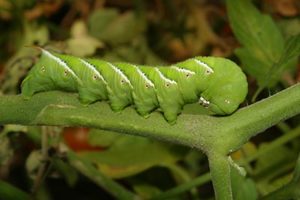- Tomato hornworm, Manduca quinquemaculata (Haworth) (Lepidoptera: Sphingidae), caterpillar. TAEX file photo.
- Tomato hornworm, Manduca quinquemaculata (Haworth) (Lepidoptera: Sphingidae), adult. TAEX file photo.
- Tobacco Hornworm larva. Photo by Mike Merchant
Common Name: Tomato hornworm
Scientific Name: Manduca quinquemaculata (Haworth)
Order: Lepidoptera
Description: Caterpillars can reach 3 to 4 inches in length, are green with prominent diagonal white stripes along the sides of the body and a black-colored “horn” on the back end.
There are a number of common hawkmoths or sphinx moths in Texas. The tobacco hornworm, Manduca sexta (Linnaeus), is very similar to the tomato hornworm in biology and the two species may be found together. The tobacco hornworm larva differs in that the white diagonal (appearing as “/” marks with the head to the left) stripes on the sides of the body appear as “/” marks. They also have a red-colored horn. Adults of the tobacco hornworm have differently patterned hind wings and 6 pairs of orange-yellow spots along the abdomen.
Life Cycle: The winter is spent as a pupa in the soil. The pupa is about 2 inches long, dark brown in color and spindle-shaped, with the encased mouthparts prominent and separated from the body, appearing like a handle. Adult moths emerge in the spring. They are large-bodied moths with a 4 to 5 inch wingspan that resemble humming birds in flight as they hover around flowers from which they obtain nectar at dusk. The moth’s abdomen is marked with five pairs of orange-yellow spots. Female moths deposit greenish-yellow eggs single on the undersides of host plant leaves. Caterpillars hatch from the eggs in about 7 days and caterpillars develop through five stages (instars) for 3 to 4 weeks until they pupate 3 to 4 inches deep in the soil. Unless the pupa overwinters, adults can emerge in about 3 weeks, producing two generations per year.
Habitat and Food Source(s): Caterpillars have chewing mouthparts. Adults have siphoning mouths. Caterpillars feed of leaves of tomato, eggplant, pepper, potato and some weeds. Adults are attracted to lights.
Pest Status: Caterpillars feed on certain plants, adult moths feed on nectar; medically harmless.
For additional information, contact your local Texas A&M AgriLife Extension Service agent or search for other state Extension offices.
Literature: Metcalf et al. 1962; Selman 1975.


